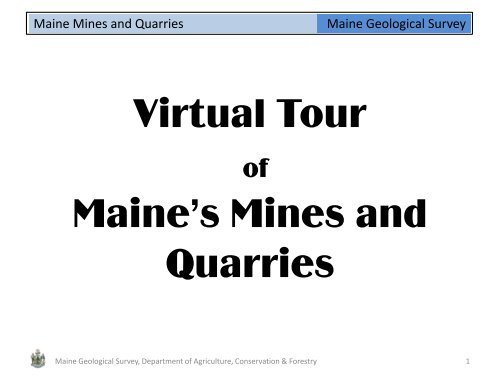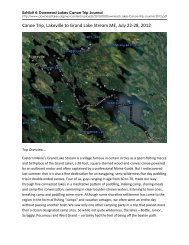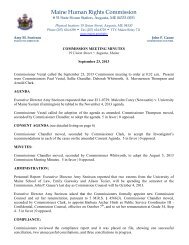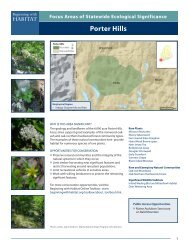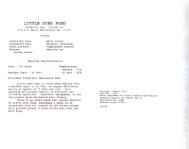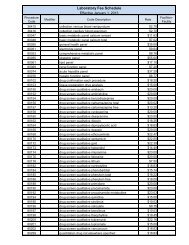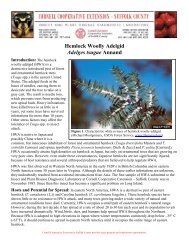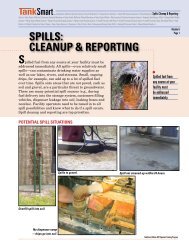Mining and quarrying (PDF 2.8 Mb) - Maine.gov
Mining and quarrying (PDF 2.8 Mb) - Maine.gov
Mining and quarrying (PDF 2.8 Mb) - Maine.gov
You also want an ePaper? Increase the reach of your titles
YUMPU automatically turns print PDFs into web optimized ePapers that Google loves.
<strong>Maine</strong> Mines <strong>and</strong> Quarries<br />
<strong>Maine</strong> Geological Survey<br />
Virtual Tour<br />
of<br />
<strong>Maine</strong>’s Mines <strong>and</strong><br />
Quarries<br />
<strong>Maine</strong> Geological Survey, Department of Agriculture, Conservation & Forestry 1
<strong>Maine</strong> Mines <strong>and</strong> Quarries<br />
<strong>Maine</strong> Geological Survey<br />
Introduction<br />
<strong>Mining</strong> in <strong>Maine</strong> has a long history unknown to many citizens. Some of us have seen the<br />
granite quarries which remain from an industry established more than 150 years ago.<br />
Gravel pits are a common sight today, <strong>and</strong> many people are familiar with <strong>Maine</strong>’s<br />
limestone, slate, <strong>and</strong> crushed stone operations. However, the well-known resources of<br />
modern times are but a few of the mineral products that have been produced in <strong>Maine</strong>.<br />
Economic conditions, technological developments, <strong>and</strong> world events have influenced the<br />
level of mining activity in our state.<br />
Contents<br />
Metals 3<br />
Stone 20<br />
Minerals 34<br />
Surficial Materials 41<br />
<strong>Maine</strong> Geological Survey, Department of Agriculture, Conservation & Forestry 2
Jackson, 1837<br />
<strong>Maine</strong> Mines <strong>and</strong> Quarries<br />
<strong>Maine</strong> Geological Survey<br />
Lubec Lead Mine Diagram<br />
Most metal mines in <strong>Maine</strong> are very small <strong>and</strong> have not been worked for a long time. One of the<br />
oldest is the Lubec Lead Mine, which was operated in the 1830's. In 1837 the first State Geologist,<br />
Charles T. Jackson, published this view of one of the ore veins <strong>and</strong> mine adits exposed in a cliff<br />
along the ocean shore.<br />
<strong>Maine</strong> Geological Survey, Department of Agriculture, Conservation & Forestry 3
<strong>Maine</strong> Mines <strong>and</strong> Quarries<br />
<strong>Maine</strong> Geological Survey<br />
Lubec Lead Mine<br />
<strong>Maine</strong> Geological Survey<br />
The old workings of the Lubec Lead Mine are still visible today <strong>and</strong> may be visited as a mineral<br />
collecting locality. Extreme caution is required to avoid being caught by rising tides in this area.<br />
<strong>Maine</strong> Geological Survey, Department of Agriculture, Conservation & Forestry 4
<strong>Maine</strong> Mines <strong>and</strong> Quarries<br />
<strong>Maine</strong> Geological Survey<br />
Katahdin Iron Works<br />
<strong>Maine</strong> Geological Survey<br />
In the mid 1840's, Katahdin Iron Works began operations to smelt bog iron. This view of the brick<br />
charcoal kilns was taken from atop the furnace. At the peak of operation, sixteen of these kilns<br />
rendered cords of wood down to the charcoal that fueled the furnace. The kiln closest to the<br />
camera (center) is the only one that still remains intact.<br />
<strong>Maine</strong> Geological Survey, Department of Agriculture, Conservation & Forestry 5
Photo by John B. Poisson<br />
<strong>Maine</strong> Mines <strong>and</strong> Quarries<br />
<strong>Maine</strong> Geological Survey<br />
Katahdin Iron Works Historic Site<br />
<strong>Maine</strong> Geological Survey<br />
The remaining brick kiln at Katahdin Iron Works, now a state historic site. The blast furnace<br />
is seen at rear left of photo.<br />
<strong>Maine</strong> Geological Survey, Department of Agriculture, Conservation & Forestry 6
Photo by John B. Poisson<br />
<strong>Maine</strong> Mines <strong>and</strong> Quarries<br />
<strong>Maine</strong> Geological Survey<br />
Blast Furnace<br />
<strong>Maine</strong> Geological Survey<br />
The remains of the blast furnace at Katahdin Iron Works.<br />
<strong>Maine</strong> Geological Survey, Department of Agriculture, Conservation & Forestry 7
<strong>Maine</strong> Mines <strong>and</strong> Quarries<br />
<strong>Maine</strong> Geological Survey<br />
<strong>Maine</strong> <strong>Mining</strong> Journal<br />
The most notorious development in <strong>Maine</strong>'s<br />
mining history was the metal mining boom of<br />
1879 to 1882. The origin of this boom is<br />
unclear, though it is said that men returning<br />
from the gold rushes in the West found a<br />
similarity between the metal-bearing rocks of<br />
<strong>Maine</strong> <strong>and</strong> ore deposits of the western states.<br />
There was great excitement as mining<br />
companies were organized, buildings were<br />
erected, expensive machinery was installed,<br />
<strong>and</strong> in some cases mills, concentrators, <strong>and</strong><br />
smelters were constructed. Much of the activity<br />
occurred around Blue Hill, Sullivan, Acton, <strong>and</strong><br />
Lubec. It soon reached such a high level that a<br />
weekly industry newspaper, the "<strong>Maine</strong> <strong>Mining</strong><br />
Journal," was published in Bangor beginning in<br />
1880.<br />
<strong>Maine</strong> Geological Survey<br />
<strong>Maine</strong> Geological Survey, Department of Agriculture, Conservation & Forestry 8
<strong>Maine</strong> Mines <strong>and</strong> Quarries<br />
<strong>Maine</strong> Geological Survey<br />
Stock Certificate<br />
<strong>Maine</strong> Geological Survey<br />
During the mining boom, a large number of mining companies were formed, each<br />
issuing stock to raise capital.<br />
<strong>Maine</strong> Geological Survey, Department of Agriculture, Conservation & Forestry 9
<strong>Maine</strong> Mines <strong>and</strong> Quarries<br />
<strong>Maine</strong> Geological Survey<br />
Douglass Mine Postcard<br />
<strong>Maine</strong> Geological Survey<br />
During the mining boom, one of the few mines to actually produce smelted metal was the<br />
Douglass Copper Mine, located in Blue Hill. This view (from a postcard) shows the<br />
construction of the milling <strong>and</strong> smelting works of the mine. The mine was operated from<br />
1878 to 1883, <strong>and</strong> in 1918.<br />
<strong>Maine</strong> Geological Survey, Department of Agriculture, Conservation & Forestry 10
<strong>Maine</strong> Mines <strong>and</strong> Quarries<br />
<strong>Maine</strong> Geological Survey<br />
Douglass Mine<br />
<strong>Maine</strong> Geological Survey<br />
Although prospecting continued <strong>and</strong> several metal mines reopened for a short time, no major<br />
mining occurred in <strong>Maine</strong> during the remainder of the 1800's. There was a brief period of activity<br />
in Cherryfield around 1905-07, when the price of silver was favorable. The shipment of copper<br />
concentrates from the Douglass Mine in Blue Hill by American Smelting <strong>and</strong> Refining Co. in 1918<br />
marked the last production of base metals from <strong>Maine</strong> mines until the late 1960's. The photo<br />
above shows the entrance to old underground workings at the Douglass Copper Mine in Blue Hill.<br />
<strong>Maine</strong> Geological Survey, Department of Agriculture, Conservation & Forestry 11
<strong>Maine</strong> Mines <strong>and</strong> Quarries<br />
<strong>Maine</strong> Geological Survey<br />
Manganese Ore<br />
During the war years of the<br />
1940's, minerals on the War<br />
Department's "strategic list"<br />
were of utmost importance. In<br />
view of the urgent need for<br />
manganese to meet the<br />
dem<strong>and</strong>s of the steel industry,<br />
work began in the summer of<br />
1941 to evaluate manganese<br />
deposits in Aroostook County<br />
that had been discovered over<br />
100 years before. Altogether,<br />
the work during the war years<br />
indicated reserves of metallic<br />
manganese in Aroostook<br />
County of about 2,100,000 tons.<br />
<strong>Maine</strong> Geological Survey<br />
The average manganese content of the ore is about 9 percent. At that time, however, a process by<br />
which manganese could be extracted economically from the type of ore found in Aroostook<br />
County had not been developed. The sample above is of manganese ore from Hovey<br />
Mountain in Aroostook County.<br />
<strong>Maine</strong> Geological Survey, Department of Agriculture, Conservation & Forestry 12
Photo courtesy of Fred Beck<br />
<strong>Maine</strong> Mines <strong>and</strong> Quarries<br />
<strong>Maine</strong> Geological Survey<br />
Callahan Mine 1970<br />
In 1965 Callahan <strong>Mining</strong> Corporation of New York acquired the old Harborside Copper Mine in<br />
Brooksville. Originally opened in the 1880's, the Harborside Mine had been leased by Penobscot<br />
<strong>Mining</strong> Corporation in the mid 1950's. The latter company had staked claims on Goose Falls Pond<br />
<strong>and</strong> delineated a sulfide ore body. Callahan <strong>Mining</strong> obtained permission from the State to<br />
temporarily drain Goose Pond, which was a tidal inlet, in order to develop an open pit copper-zinc<br />
mine at the Harborside property. The photo above shows the open pit at the Callahan Mine,<br />
Brooksville, ca. 1970, when the mine was active.<br />
<strong>Maine</strong> Geological Survey, Department of Agriculture, Conservation & Forestry 13
<strong>Maine</strong> Mines <strong>and</strong> Quarries<br />
<strong>Maine</strong> Geological Survey<br />
Callahan Mine Mill Complex<br />
<strong>Maine</strong> Geological Survey<br />
Callahan <strong>Mining</strong> Corporation built a flotation mill to extract copper <strong>and</strong> zinc concentrates from the<br />
ore, <strong>and</strong> began mining in 1968. The copper concentrates were shipped to the Nor<strong>and</strong>a smelter in<br />
Gaspe, while the zinc concentrates went to a smelter in Pennsylvania. The photo above shows the<br />
Callahan Mine mill complex.<br />
<strong>Maine</strong> Geological Survey, Department of Agriculture, Conservation & Forestry 14
Photo by Woodrow B. Thompson<br />
<strong>Maine</strong> Mines <strong>and</strong> Quarries<br />
<strong>Maine</strong> Geological Survey<br />
Callahan Mine Core<br />
<strong>Maine</strong> Geological Survey<br />
In 1972, after 5 years of production, Callahan <strong>Mining</strong> closed its copper-zinc mining <strong>and</strong> milling<br />
operation at Harborside in Brooksville due to depletion of reserves. During this time the Callahan<br />
Mine had yielded 800,000 tons of ore grading 5.5% zinc, 1.25% copper, 0.5% lead, <strong>and</strong> 0.5 oz/ton<br />
silver. The photo shows a giant rock core at the site of the Callahan Mine in Brooksville.<br />
<strong>Maine</strong> Geological Survey, Department of Agriculture, Conservation & Forestry 15
<strong>Maine</strong> Mines <strong>and</strong> Quarries<br />
<strong>Maine</strong> Geological Survey<br />
Black Hawk Mine Shaft<br />
<strong>Maine</strong> Geological Survey<br />
Late in 1972, Kerramerican, a subsidiary of Kerr Addison of Toronto, commenced production at the<br />
Black Hawk Mine in Blue Hill. The photo above shows miners sinking a shaft at the Black Hawk<br />
Mine during the mid 1960's.<br />
<strong>Maine</strong> Geological Survey, Department of Agriculture, Conservation & Forestry 16
<strong>Maine</strong> Mines <strong>and</strong> Quarries<br />
<strong>Maine</strong> Geological Survey<br />
Black Hawk Mill<br />
<strong>Maine</strong> Geological Survey<br />
Black Hawk (Kerr American) mill construction, next to Second Pond, Blue Hill. The ore was<br />
processed on site for zinc <strong>and</strong> copper concentrates, which were shipped out of state for smelting.<br />
<strong>Mining</strong> continued until the fall of 1977. Based on extrapolation of 1976 statistics, it is estimated<br />
that the total output of the Black Hawk Mine during this period was approximately 1,000,000 tons<br />
containing 7.35% zinc, 0.89% copper, <strong>and</strong> 0.35% lead.<br />
<strong>Maine</strong> Geological Survey, Department of Agriculture, Conservation & Forestry 17
<strong>Maine</strong> Mines <strong>and</strong> Quarries<br />
<strong>Maine</strong> Geological Survey<br />
Black Hawk Mine<br />
<strong>Maine</strong> Geological Survey<br />
Headframe of the Black Hawk Mine. After operations ceased, equipment was removed from the<br />
mine <strong>and</strong> the mine openings were sealed with concrete bulkheads. To reclaim the sulfide tailings,<br />
glacial till <strong>and</strong> topsoil were graded over the tailings <strong>and</strong> reseeded.<br />
<strong>Maine</strong> Geological Survey, Department of Agriculture, Conservation & Forestry 18
<strong>Maine</strong> Mines <strong>and</strong> Quarries<br />
<strong>Maine</strong> Geological Survey<br />
Bald Mountain Ore<br />
<strong>Maine</strong> Geological Survey<br />
In September, 1977, a 36 million-ton massive copper-zinc sulfide deposit was discovered at Bald<br />
Mountain in T12 R8, Aroostook County, <strong>Maine</strong>. It was estimated by some to be the third most<br />
significant copper discovery on the North American continent since the 1950's. The discovery of<br />
the Bald Mountain deposit was the culmination of years of exploration by <strong>Maine</strong> geologist John S.<br />
Cummings. Utilizing innovative geochemical techniques coupled with persistence, patience, <strong>and</strong><br />
trial <strong>and</strong> error, Cummings pinpointed the deposit in an assemblage of volcanic rocks which extend<br />
for approximtely 130 miles in a belt 50-60 miles wide across north-central <strong>Maine</strong>. As of this date,<br />
the deposit has not been developed.<br />
<strong>Maine</strong> Geological Survey, Department of Agriculture, Conservation & Forestry 19
Photo from Dale, USGS B-313<br />
<strong>Maine</strong> Mines <strong>and</strong> Quarries<br />
<strong>Maine</strong> Geological Survey<br />
Stinchfield Quarry<br />
During the 1800's, granite was a<br />
commodity of great importance.<br />
<strong>Maine</strong> had several advantages<br />
that made it the principal<br />
supplier of granite to the rest of<br />
the Atlantic states <strong>and</strong> the West<br />
Indies. The greatest advantage<br />
was that most of the important<br />
quarries were readily accessible<br />
by navigable rivers, bays, or<br />
inlets. Thus the shipping costs for<br />
<strong>Maine</strong> granite were considerably<br />
less than for other types of<br />
building stone.<br />
Quarrying was concentrated around Penobscot Bay, eastern Washington County, Hallowell,<br />
Biddeford, <strong>and</strong> the Blue Hill area. The granite industry reached its high point in 1901, with 152<br />
quarries employing at least 3,500 men. <strong>Maine</strong> ranked first in the country in terms of value of<br />
granite produced. The photo above shows the Stinchfield Quarry near Hallowell, circa 1900.<br />
<strong>Maine</strong> Geological Survey, Department of Agriculture, Conservation & Forestry 20
Photo from Dale, USGS B-313<br />
<strong>Maine</strong> Mines <strong>and</strong> Quarries<br />
<strong>Maine</strong> Geological Survey<br />
Granite Columns<br />
Monolithic columns of coarse-textured biotite granite quarried at Palmer Quarry, Vinalhaven, for<br />
the Cathedral of St. John the Divine, at New York - circa early 1900's (photo from Dale, USGS B-<br />
313). <strong>Maine</strong> granite was used for everything from bridge supports <strong>and</strong> piers to tombstones. Many<br />
public buildings, churches, <strong>and</strong> monuments, particularly in New York City, are constructed of<br />
<strong>Maine</strong> granite. Examples include the State House in Augusta, <strong>Maine</strong>; post offices in Philadelphia,<br />
Buffalo, Hartford, <strong>and</strong> Albany; custom houses in St. Louis, Boston, <strong>and</strong> Brooklyn; Grant's Tomb in<br />
New York; paving stones in New York <strong>and</strong> Philadelphia; <strong>and</strong> the gatehouse in Central Park.<br />
<strong>Maine</strong> Geological Survey, Department of Agriculture, Conservation & Forestry 21
<strong>Maine</strong> Mines <strong>and</strong> Quarries<br />
<strong>Maine</strong> Geological Survey<br />
Quarry Hoist Engine<br />
<strong>Maine</strong> Geological Survey<br />
The development of Portl<strong>and</strong> cement as a building material in the early 1900's, <strong>and</strong> the depression<br />
of the 1930's, dealt <strong>Maine</strong>'s granite industry a blow from which it would never recover. Most<br />
quarries in the state ceased production, leaving inactive quarry pits <strong>and</strong> bits of rusting machinery.<br />
The photo above shows the remains of a quarry hoist engine at the New Engl<strong>and</strong> Stone quarry on<br />
Crotch Isl<strong>and</strong> in Stonington. Occasionally, old quarries may be reactivated for special projects.<br />
<strong>Maine</strong> Geological Survey, Department of Agriculture, Conservation & Forestry 22
<strong>Maine</strong> Mines <strong>and</strong> Quarries<br />
<strong>Maine</strong> Geological Survey<br />
New Engl<strong>and</strong> Stone Quarry<br />
<strong>Maine</strong> Geological Survey<br />
New Engl<strong>and</strong> Stone quarry, Crotch Isl<strong>and</strong>, Stonington. One of the few remaining active<br />
quarries in <strong>Maine</strong>.<br />
<strong>Maine</strong> Geological Survey, Department of Agriculture, Conservation & Forestry 23
<strong>Maine</strong> Mines <strong>and</strong> Quarries<br />
<strong>Maine</strong> Geological Survey<br />
Deer Isle Granite<br />
<strong>Maine</strong> Geological Survey<br />
Large block of Deer Isle granite at the New Engl<strong>and</strong> Stone quarry, Crotch Isl<strong>and</strong>, Stonington.<br />
<strong>Maine</strong> Geological Survey, Department of Agriculture, Conservation & Forestry 24
Photo from T. N. Dale, USGS Bulletin 275<br />
<strong>Maine</strong> Mines <strong>and</strong> Quarries<br />
<strong>Maine</strong> Geological Survey<br />
Merrill Slate Quarry<br />
The <strong>Maine</strong> slate industry was also big in its day. From 1880 to 1904 <strong>Maine</strong> was among the top five<br />
slate-producing states in the country, providing slate of excellent quality for roofing tiles <strong>and</strong> other<br />
purposes. Many <strong>Maine</strong> homes <strong>and</strong> public buildings dating to that time are still protected by their<br />
original slate roofs. The "Central <strong>Maine</strong> Slate Belt" extends approximately from Waterville to<br />
Brownville Junction, with most activity having been in southern Piscataquis County. The photo<br />
above shows the Merrill Slate Quarry at Brownville<br />
<strong>Maine</strong> Geological Survey, Department of Agriculture, Conservation & Forestry 25
<strong>Maine</strong> Mines <strong>and</strong> Quarries<br />
<strong>Maine</strong> Geological Survey<br />
Slate<br />
<strong>Maine</strong> Geological Survey<br />
Although most slate quarries in <strong>Maine</strong> have closed, there is still an active operation in Monson.<br />
The photo above shows slate slabs stockpiled at the Sheldon Slate Company.<br />
<strong>Maine</strong> Geological Survey, Department of Agriculture, Conservation & Forestry 26
<strong>Maine</strong> Mines <strong>and</strong> Quarries<br />
<strong>Maine</strong> Geological Survey<br />
Cutting Slate<br />
<strong>Maine</strong> Geological Survey<br />
Cutting slate at the Sheldon Slate Company, Monson.<br />
<strong>Maine</strong> Geological Survey, Department of Agriculture, Conservation & Forestry 27
Illustration from Jackson, 1839, p. 64<br />
<strong>Maine</strong> Mines <strong>and</strong> Quarries<br />
<strong>Maine</strong> Geological Survey<br />
Lime Kiln<br />
<strong>Maine</strong> was also well known for its limestone<br />
<strong>quarrying</strong> in the early 1800's. Activity was<br />
concentrated then, as it is now, in the Thomaston<br />
area. C. T. Jackson estimated that at least $14<br />
million worth of limestone lay within 20 feet of<br />
the surface in Thomaston. The annual lime<br />
production was valued at about one-half million<br />
dollars. It was used for agriculture <strong>and</strong> the<br />
manufacture of wall plaster. The diagram above<br />
shows the structure of a "perpetual lime kiln" at<br />
the State prison in 1838.<br />
<strong>Maine</strong> Geological Survey, Department of Agriculture, Conservation & Forestry 28
<strong>Maine</strong> Mines <strong>and</strong> Quarries<br />
<strong>Maine</strong> Geological Survey<br />
Rockport Lime Kilns Sign<br />
<strong>Maine</strong> Geological Survey<br />
During the 1800's, Rockport was a major supplier of lime to markets on the East Coast. Lime kilns<br />
<strong>Maine</strong> Geological Survey<br />
converted limestone from local quarries into lime used to produce mortar <strong>and</strong> plaster. The image<br />
above is a photo of an interpretive sign located at Rockport Marine Park. The drawing shows<br />
limestone being unloaded from rail cars into the kilns. The limestone was burned in the kilns to<br />
produce lime, which was then packed in casks <strong>and</strong> shipped to waiting markets.<br />
<strong>Maine</strong> Geological Survey, Department of Agriculture, Conservation & Forestry 29
<strong>Maine</strong> Mines <strong>and</strong> Quarries<br />
<strong>Maine</strong> Geological Survey<br />
Rockport Lime Kilns<br />
<strong>Maine</strong> Geological Survey<br />
A devastating fire in 1907 destroyed most of the wooden buildings surrounding the kilns. The local<br />
lime industry never recovered. The photo above shows some of the remaining kilns as they appear<br />
today in Rockport Marine Park.<br />
<strong>Maine</strong> Geological Survey, Department of Agriculture, Conservation & Forestry 30
<strong>Maine</strong> Mines <strong>and</strong> Quarries<br />
<strong>Maine</strong> Geological Survey<br />
Dragon Cement<br />
<strong>Maine</strong> Geological Survey<br />
The Dragon Cement plant in Thomaston is the only cement manufacturing plant in New Engl<strong>and</strong><br />
<strong>and</strong> has been in continuous operation since 1928. The adjacent limestone quarry provides rock of<br />
the necessary chemistry for cement manufacturing. This photo shows the marble (limestone)<br />
quarry, north of Route 1 in Thomaston, Me. The crushing mill <strong>and</strong> kiln can be seen in the<br />
background.<br />
<strong>Maine</strong> Geological Survey, Department of Agriculture, Conservation & Forestry 31
<strong>Maine</strong> Mines <strong>and</strong> Quarries<br />
<strong>Maine</strong> Geological Survey<br />
Blue Rock Quarry<br />
<strong>Maine</strong> Geological Survey<br />
The resource of greatest economic value in recent years is "aggregate," which is unconsolidated<br />
material such as s<strong>and</strong>, gravel, or crushed stone used for paving <strong>and</strong> construction. This photo shows<br />
the Blue Rock quarry between Westbrook <strong>and</strong> Portl<strong>and</strong>. Biotite granofels of the Berwick Formation<br />
is quarried here for crushed rock aggregate. The <strong>Maine</strong> Turnpike is seen in the center of the photo.<br />
<strong>Maine</strong> Geological Survey, Department of Agriculture, Conservation & Forestry 32
<strong>Maine</strong> Mines <strong>and</strong> Quarries<br />
<strong>Maine</strong> Geological Survey<br />
Blue Rock Crushed Stone<br />
<strong>Maine</strong> Geological Survey<br />
Crushing <strong>and</strong> sorting equipment at the Blue Rock quarry in Westbrook.<br />
<strong>Maine</strong> Geological Survey, Department of Agriculture, Conservation & Forestry 33
<strong>Maine</strong> Mines <strong>and</strong> Quarries<br />
<strong>Maine</strong> Geological Survey<br />
Mount Mica<br />
<strong>Maine</strong> Geological Survey<br />
Mount Mica, near the village of Paris Hill, is home to one of the oldest gem tourmaline localities in<br />
the country, having been discovered in 1820. The quarry on Mount Mica has been worked<br />
intermittently for over 180 years. (postcard from early 1900's)<br />
<strong>Maine</strong> Geological Survey, Department of Agriculture, Conservation & Forestry 34
Photo from E. S. Bastin, 1911<br />
<strong>Maine</strong> Mines <strong>and</strong> Quarries<br />
<strong>Maine</strong> Geological Survey<br />
Mount Mica Pockets<br />
In the early days at Mount Mica, many tourmaline pockets were found near the surface of the<br />
ground. Sticks mark locations of gem pockets.<br />
<strong>Maine</strong> Geological Survey, Department of Agriculture, Conservation & Forestry 35
<strong>Maine</strong> Mines <strong>and</strong> Quarries<br />
<strong>Maine</strong> Geological Survey<br />
Mount Mica 2004<br />
<strong>Maine</strong> Geological Survey<br />
The western part of Mount Mica in 2004. Gary Freeman continues to operate this historic mine. It<br />
is yielding fine tourmaline crystals that rival the best ever found in the past, along with unusual<br />
blue apatites, giant smoky quartz crystals, <strong>and</strong> other rarities.<br />
<strong>Maine</strong> Geological Survey, Department of Agriculture, Conservation & Forestry 36
Photo courtesy of G. Freeman<br />
<strong>Maine</strong> Mines <strong>and</strong> Quarries<br />
<strong>Maine</strong> Geological Survey<br />
Giant Tourmaline<br />
Mary Freeman holding a giant tourmaline<br />
specimen just after its discovery at Mount Mica.<br />
Specimens from the tourmaline pockets usually<br />
are not colorful <strong>and</strong> sparkly when they are fresh<br />
out of the ground. Cleaning is required at the end<br />
of the day to remove coatings of rust <strong>and</strong> mud<br />
from both minerals <strong>and</strong> miners!<br />
<strong>Maine</strong> Geological Survey, Department of Agriculture, Conservation & Forestry 37
Photo courtesy of G. Freeman<br />
<strong>Maine</strong> Mines <strong>and</strong> Quarries<br />
<strong>Maine</strong> Geological Survey<br />
Cleaned Giant Tourmaline<br />
The same specimen seen in previous photo, after<br />
cleaning. It shows a columnar pink <strong>and</strong> green<br />
tourmaline crystal with a matrix of quartz crystals.<br />
The shape <strong>and</strong> color scheme of this crystal<br />
resemble a large tourmaline found at Mount Mica<br />
by Loren Merrill in 1904 <strong>and</strong> now in the collection<br />
of Harvard University.<br />
<strong>Maine</strong> Geological Survey, Department of Agriculture, Conservation & Forestry 38
Photo by Woodrow B. Thompson<br />
<strong>Maine</strong> Mines <strong>and</strong> Quarries<br />
<strong>Maine</strong> Geological Survey<br />
Feldspar Mill<br />
<strong>Maine</strong> Geological Survey<br />
The feldspar mill in West Paris, constructed in 1925 for the Oxford <strong>Mining</strong> <strong>and</strong> Milling Company,<br />
was important in the development of the feldspar industry in Oxford County. In the 1980's,<br />
Industrial Garnet Extractives developed the Wing Hill Mine in Rangeley for garnet-bearing diorite.<br />
The garnet was separated at the Bell Minerals Company feldspar mill in West Paris, <strong>and</strong> was used<br />
for a variety of industrial products including water filters, abrasives, <strong>and</strong> packing media. This<br />
operation was one of four garnet producers in the United States. It closed in May, 1988 due to<br />
supply <strong>and</strong> milling problems. The mill was inactive when this photo was taken (1990).<br />
<strong>Maine</strong> Geological Survey, Department of Agriculture, Conservation & Forestry 39
Photo by Neil wintringham<br />
<strong>Maine</strong> Mines <strong>and</strong> Quarries<br />
<strong>Maine</strong> Geological Survey<br />
Tamminen Quarry<br />
<strong>Maine</strong> Geological Survey<br />
Feldspar mining operation at the Tamminen Quarry, Greenwood, 1952. Note trays loaded with<br />
feldspar, next to derrick.<br />
<strong>Maine</strong> Geological Survey, Department of Agriculture, Conservation & Forestry 40
<strong>Maine</strong> Mines <strong>and</strong> Quarries<br />
<strong>Maine</strong> Geological Survey<br />
Topsham Gravel Pit<br />
<strong>Maine</strong> Geological Survey<br />
S<strong>and</strong> <strong>and</strong> gravel is a basic component of concrete used in commercial <strong>and</strong> industrial buildings <strong>and</strong><br />
public works projects. It also receives wide use as a base material in the construction <strong>and</strong> repair of<br />
highways, railways <strong>and</strong> airport runways. In <strong>Maine</strong>, this has been the resource with the greatest<br />
economic value in recent years. Glacial s<strong>and</strong> <strong>and</strong> gravel deposits across the state have been mined<br />
for this purpose. This photo shows a very large gravel pit near the Androscoggin River in Topsham.<br />
<strong>Maine</strong> Geological Survey, Department of Agriculture, Conservation & Forestry 41
<strong>Maine</strong> Mines <strong>and</strong> Quarries<br />
<strong>Maine</strong> Geological Survey<br />
Whitefield Gravel Pit<br />
<strong>Maine</strong> Geological Survey<br />
Gravel size sorting operation in a pit in the Palmer Hill delta in Whitefield.<br />
<strong>Maine</strong> Geological Survey, Department of Agriculture, Conservation & Forestry 42
<strong>Maine</strong> Mines <strong>and</strong> Quarries<br />
<strong>Maine</strong> Geological Survey<br />
Clay Deposits<br />
<strong>Maine</strong> Geological Survey<br />
Clay has been mined in <strong>Maine</strong> for well over a century. Clay deposits are widespread in <strong>Maine</strong>'s<br />
coastal counties, particularly in the Presumpscot Formation of Pleistocene age. This formation<br />
originated as finely ground "rock flour" produced by glacial abrasion, <strong>and</strong> has a complex mineral<br />
makeup. This clay is quite suitable for common brick made in local brickyards. The photo shows an<br />
exposure of Presumpscot Formation clay in Gardiner.<br />
<strong>Maine</strong> Geological Survey, Department of Agriculture, Conservation & Forestry 43
<strong>Maine</strong> Mines <strong>and</strong> Quarries<br />
<strong>Maine</strong> Geological Survey<br />
Morin Brick Company<br />
<strong>Maine</strong> Geological Survey<br />
The Morin Brick Company in Auburn makes brick from clay mined at a nearby pit. Clay from the pit<br />
is trucked to the manufacturing plant where it is sized, mixed with additives, formed into bricks,<br />
<strong>and</strong> fired in a kiln.<br />
<strong>Maine</strong> Geological Survey, Department of Agriculture, Conservation & Forestry 44
<strong>Maine</strong> Mines <strong>and</strong> Quarries<br />
<strong>Maine</strong> Geological Survey<br />
Colby College<br />
<strong>Maine</strong> Geological Survey<br />
The buildings of Colby College in Waterville are constructed of brick produced by the Morin Brick<br />
Company. It is estimated that the campus is built of some 50 million <strong>Maine</strong>-made "Colby" bricks.<br />
<strong>Maine</strong> Geological Survey, Department of Agriculture, Conservation & Forestry 45
<strong>Maine</strong> Mines <strong>and</strong> Quarries<br />
<strong>Maine</strong> Geological Survey<br />
Peat Harvester<br />
<strong>Maine</strong> Geological Survey<br />
Peat was harvested in a number of <strong>Maine</strong> towns during the early 1940's, including Centerville,<br />
Deblois, Franklin, Friendship, Jonesport, Penobscot, <strong>and</strong> Sullivan. Harvesting of peat for<br />
agricultural uses has continued on a limited basis until the present day. The photo above shows a<br />
peat harvester on the Denbo Heath in 1980.<br />
<strong>Maine</strong> Geological Survey, Department of Agriculture, Conservation & Forestry 46
<strong>Maine</strong> Mines <strong>and</strong> Quarries<br />
<strong>Maine</strong> Geological Survey<br />
Martian Bigfoot<br />
<strong>Maine</strong> Geological Survey<br />
A variety of equipment has been used to harvest peat in <strong>Maine</strong>. One of the most interesting was<br />
the "Martian Bigfoot," shown here on Denbo Heath in 1980.<br />
<strong>Maine</strong> Geological Survey, Department of Agriculture, Conservation & Forestry 47
<strong>Maine</strong> Mines <strong>and</strong> Quarries<br />
<strong>Maine</strong> Geological Survey<br />
References<br />
Bastin, Edson Sunderl<strong>and</strong>, 1911, Geology of the pegmatites <strong>and</strong> associated rocks of <strong>Maine</strong>, including<br />
feldspar, quartz, mica, <strong>and</strong> gem deposits; U. S. Geological Survey, Bulletin 445, 152 p.<br />
Bl<strong>and</strong>ing, E. M., <strong>and</strong> Bl<strong>and</strong>ing, W. F. (editors), 1880, <strong>Maine</strong> <strong>Mining</strong> Journal; A weekly newspaper<br />
devoted to mining, published from January 3, 1880, to September 22, 1882, 28 West Market Square,<br />
Bangor, <strong>Maine</strong><br />
Dale, Thomas Nelson, 1906, Slate deposits <strong>and</strong> slate industry of the United States [<strong>Maine</strong>]; U. S.<br />
Geological Survey, Bulletin 275, p. 60-67, 123-131.<br />
Dale, Thomas Nelson, 1907, The granites of <strong>Maine</strong>; U. S. Geological Survey, Bulletin 313, 202 p.<br />
Hamlin, Augustus Choate, 1873, The tourmaline; Its relation as a gem; its complex nature; its<br />
wonderful physical properties, etc., etc.,; with special reference to the beautiful <strong>and</strong> matchless<br />
crystals found in the State of <strong>Maine</strong>; James R. Osgood <strong>and</strong> Co., Boston, Massachusetts, 107 p.<br />
Jackson, Charles T., 1837, List of mines <strong>and</strong> minerals belonging to the <strong>Maine</strong> <strong>Mining</strong> Co.; Boston, 16 p.<br />
Jackson, Charles T., 1839, Third annual report on the geology of the State of <strong>Maine</strong>; Smith &<br />
Robinson, Printers to the State, Augusta, <strong>Maine</strong>, 276 p.<br />
King, V<strong>and</strong>all T., <strong>and</strong> Foord, Eugene E., 1994, Mineralogy of <strong>Maine</strong> Volume 1: Descriptive Mineralogy:<br />
<strong>Maine</strong> Geological Survey (Department of Conservation), 418 p.<br />
<strong>Maine</strong> Geological Survey, Department of Agriculture, Conservation & Forestry 48


